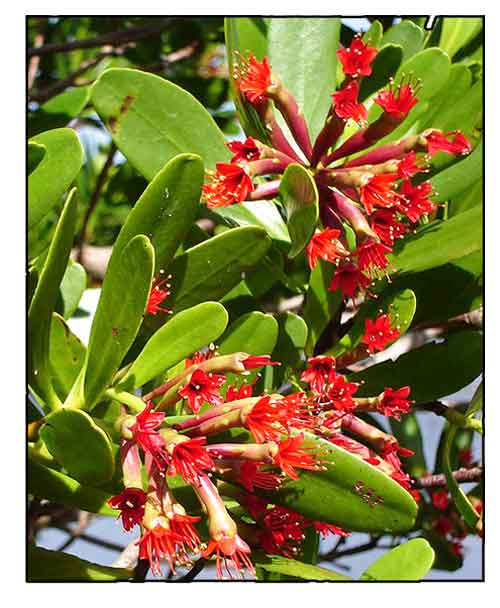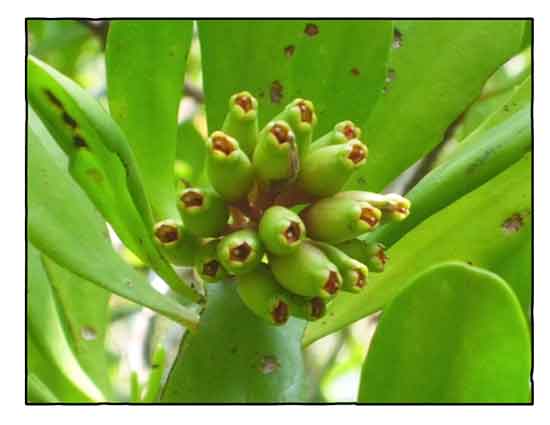 Gen info Gen info
- Lumnitzera is an Indo-West Pacific mangrove genus in the family Combretaceae.
-
The genus has two species of similar vegetative appearance, differing in color: Lumnitzera littorea with red flowers and L. racemosa with white flowers. Both have flat and spoon-shaped (spathulate) leaves with emarginate tips. (2)
- Etymology: The genus name Lumnitzera honors the German botanist, Stephan Lumnitzer (1750-1806), who published Flora Posiensis in 1791, which described the Flora of Bratislava. the capital of Slovenkia.
Botany
• Growth form: A relatively small to medium sized tree, reaching up to 25 m when growing in favorable conditions. It has no buttress, but produces pneumatophores. Bark is dark brown and fissured. Foliage: Alternate, shortly-stalked leaves have obovate leaf blades that are 2-9 by 1-2.5 cm, slightly thick and fleshy. Flowers: Shortly-stalked, scented flowers are 1-3 by 0.5 cm, with green fused sepals, and bright red petals. Fruit: One-seeded fruits are vase-shaped, tinged red, and are 1-2 by 0.3-0.7 cm, with a fibrous fruit wall, allowing it to float. (6)
• Trees to 7(-25) m tall; trunk to 0.5 m d.b.h. Bark dark blackish brown, deeply longitudinally fissured. Branchlets reddish or green when young, glabrous. Leaf blade dark green adaxially, oblanceolate or narrowly oblong-oblanceolate, (2-)4-8 × 1-3 cm, apex retuse or rounded; lateral veins in 4 or 5 pairs. Inflorescences terminal, 3-4.5 cm. Calyx tube 12-18 mm; bracteoles 1.5-2 mm; lobes broadly triangular, 1-1.5 mm, apex obtuse. Petals bright red, oblong-elliptic, 5-6 mm, apex obtuse or acuminate. Stamens 5-10 (usually 7), ca. 10 mm, ca. 2 × as long as petals. Style ca. 10 mm. Fruit blackish brown when ripe, fusiform, 1.6-2 cm × 4-5 mm excluding stipe, longitudinally striate; stipe ca. 5 mm. (Flora of China)
Distribution
- Native to the Philippines.
- Also native to Andaman Is., Borneo, Cambodia, Caroline Is., Fiji, Gilbert Is., Hainan, Jawa, Lesser Sunda Is., Malaya, Maluku, Marianas, Marshall Is., Myanmar, New Guinea, Nicobar Is., Northern Territory, Queensland, Solomon Is., Sri Lanka, Sulawesi, Sumatera, Thailand, Tonga, Tuvalu, Vanuatu, Vietnam. (1)
 Constituents Constituents
- Study of n-hexane extract of leaves yielded nine compounds including lupeol (1), betulin (2), betulinic acid (3), oleanolic acid (4), corosolic acid (5), -sitosterol (6), beta-sitosterol 3-O- beta-D-glucopyranoside (7), stigmast-5-ene-3beta-O-(6-O-hexadecanoyl-beta-D-glucopyranoside) (8), and stigmast-4-ene-3-one (9). (see study below) (4)
- Study of methanol extract of twigs isolated a new macrocyclic lactone, 12-hydroxycorniculatolide A (1), along with three known compounds, corniculatolide A (2), 12-hydroxy-11-O-methylcorniculatolide A (3) and 6,7-dimethoxycoumarin (4). (see study below) (8)
- Study of ethyl acetate and methanol extracts of leaves and stems isolated 11 compounds elucidated as
two resorcinolic lipids (1,3-dihydroxy-2-methyl-5-tridecylbenzene (1),1,3-dihydroxy-5-nonadecyl-benzene (2), two flavonoids (quercetin 3 and astragalin 4), two hexitols (1-acetyl-D-mannitol 5 and D-mannitol 6), α-D-glucopyranosyl-β-D-glucopyranoside (Neotrehalose 7) as octaacetate, fructopyranose as tetraacetate (8), β-sitosterol glycoside (9), β-sitosterol (10) and stigmasterol (11) as a mixture of 1:1 ratio. (13)
`Properties
- Studies have suggest antimicrobial, α-glucosidase inhibitory, cytotoxicity, antioxidant properties.
Parts used
- Leaves, roots, flowers.
 Uses Uses
Edibility
- Leaves reportedly edible.
Folkloric
- In the Philippines, decoction of leaves used to treat thrush in infants.
- Leaves are used to treat pimples, sprue, thrush in infants, and promote hair growth. Roots uses to treat fever and constipation, induced sweating, and to make a soothing cream and diuretic medicine. (5)
- In Indonesia, flowers used in an herbal mix for the treatment of malaria. Maba ethnics used an herbal mix of L. littorea flowers, flowers of S. alba, and fruits of R. mucronata for treatment of malaria. Red flowers used as sleeping aid with additional ingredient of sweet liquid of enau (Arenga pinnata). (9)
- In Sri Lanka, used to treat celiac disease. (14)
Others
- Wood: Timber is hard; used for heavy construction such as bridges, canoes, axles, house posts, flooring, furniture, and tool handles.
- Crafts: Bark used for making grass skirts, ropes, and strings. (5)
- Fuel: Used as firewood.
- Cooking: Branches used for smoking fish.
Studies
• Antibacterial / Roots: Study evaluated two Indonesian mangroves, Lumnitzera littorea and L. racemosa for unusual sulfated constituents and anti-infective properties. Phytochemical characterization of both species revealed unusual diversity in sulfated constituents with 3,3’,4’-tri-O-methyl-ellagic acid 4-sulfate representing the major compound in most samples. Two extracts (LL8 and LR7) completely inhibited the growth of Gram(+) Bacillus subtlis. (3)
-α-Glucoidase Inhibitory Activity / Leaves: Study of n-hexane extract of leaves yielded nine compounds including lupeol (1), betulin (2), betulinic acid (3), oleanolic acid (4), corosolic acid (5), -sitosterol (6), beta-sitosterol 3-O- beta-D-glucopyranoside (7), stigmast-5-ene-3beta-O-(6-O-hexadecanoyl-beta-D-glucopyranoside) (8), and stigmast-4-ene-3-one (9). Thatcorosolic acid and oleanolic acid (4 and 5) showed most potent alpha-glucosidase inhibitory activity with IC50s of 17.86 and 18.82 µg/mL, respectively. The other five showed IC50s below 100 µg/mL, higher than positive control acarbose at 127.64 µg/mL. (4)
• Antimicrobial / Roots: Study evaluated the antimicrobial activities of n-hexane, ethyl acetate, and methanol extracts of L. littorea leaves against six human pathogenic microbes using disc diffusion and microdilution methods. The crude extracts showed antimicrobial activities with increasing concentration. Most sensitive strain was Gram(+) Bacillus cereus with inhibition of microbial growth as low as 0.04 mg/mL indicating potent antimicrobial activity. (5)
• Antioxidant / Antibacterial / Bark, Twigs, Stems: Study evaluated the phytochemical composition, antioxidant, and antibacterial properties of stem-bark, leaf, twig, and flower extracts of L. littorea. Results showed presence of phenolic and flavonoid compounds in all extracts, with bark and twigs showing greater contents than flower and leaf extracts. All extracts exhibited a wide range of antibacterial activity against tested pathogens (Streptococcus agalactiae, Aeromonas hydrophila, Vibrio harveyi, and V. parahemolyticus) using hole plate diffusion method. Bark and twigs showed significant antioxidant activity by DPPH and ABTS assays. (7)
• Antibacterial / 12-Hydroxycorniculatolide A / Twigs: Study of methanol extract of twigs isolated a new macrocyclic lactone, 12-hydroxycorniculatolide A (1), along with three known compounds, corniculatolide A (2), 12-hydroxy-11-O-methylcorniculatolide A (3) and 6,7-dimethoxycoumarin (4). All compounds were screened against a panel of six Gram(+) and five Gram(-) bacterial. Only compound 1 showed modest activity against Staphylococcus aureus with MIC of 64 µg/mL. (8)
• Antimicrobial / Secondary Metabolites from L. littorea-Derived Fungus: Study of ethanol extract of fermentation broth of L. littorea-derived endophytic fungus Penicillium oxalicum HLLG-13 isolated five new compounds, together with ten known compounds. Compounds 5 and 9-14 exhibited antibacterial activities against Staphylococcus epidermis and Candida albicans with MICs ranging from 6.25 to 25 µg/mL. Compounds 1-6 and 9-14 showed significant growth inhibition against newly hatched Helicoverpa armigera Hubner larvae, with IC50s ranging from 50 to 200 µg/mL. (10)
- Lumnitzerone / α-Glucoidase Inhibitory Activity / Leaves: Study of leaves from L. littorea isolated a new flavone glycoside, lumnitzerone (1), along with 9 known flavonoids. Extracts and most of the isolated compounds exhibited better α-glucosidase inhibitory activity than positive control acarbose. (11)
- Selective Cytotoxicity / Stem Bark: In a study of 116 extracts, the ethyl acetate extract of stem bark of L. littorea showed selective cytotoxic effects against MCF-7 breast cancer cells. (14)
Availability
Wild-crafted.
|

![]()






